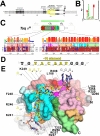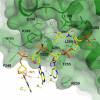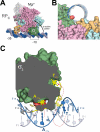Structural basis for promoter-10 element recognition by the bacterial RNA polymerase σ subunit
- PMID: 22136875
- PMCID: PMC3245737
- DOI: 10.1016/j.cell.2011.10.041
Structural basis for promoter-10 element recognition by the bacterial RNA polymerase σ subunit
Abstract
The key step in bacterial promoter opening is recognition of the -10 promoter element (T(-12)A(-11)T(-10)A(-9)A(-8)T(-7) consensus sequence) by the RNA polymerase σ subunit. We determined crystal structures of σ domain 2 bound to single-stranded DNA bearing-10 element sequences. Extensive interactions occur between the protein and the DNA backbone of every -10 element nucleotide. Base-specific interactions occur primarily with A(-11) and T(-7), which are flipped out of the single-stranded DNA base stack and buried deep in protein pockets. The structures, along with biochemical data, support a model where the recognition of the -10 element sequence drives initial promoter opening as the bases of the nontemplate strand are extruded from the DNA double-helix and captured by σ. These results provide a detailed structural basis for the critical roles of A(-11) and T(-7) in promoter melting and reveal important insights into the initiation of transcription bubble formation.
Copyright © 2011 Elsevier Inc. All rights reserved.
Figures






Comment in
-
Lock and key to transcription: σ-DNA interaction.Cell. 2011 Dec 9;147(6):1218-9. doi: 10.1016/j.cell.2011.11.033. Cell. 2011. PMID: 22153066
Similar articles
-
Structure of the bacterial RNA polymerase promoter specificity sigma subunit.Mol Cell. 2002 Mar;9(3):527-39. doi: 10.1016/s1097-2765(02)00470-7. Mol Cell. 2002. PMID: 11931761
-
Structural basis of transcription initiation.Science. 2012 Nov 23;338(6110):1076-80. doi: 10.1126/science.1227786. Epub 2012 Oct 18. Science. 2012. PMID: 23086998 Free PMC article.
-
A fork junction DNA-protein switch that controls promoter melting by the bacterial enhancer-dependent sigma factor.EMBO J. 1999 Jul 1;18(13):3736-45. doi: 10.1093/emboj/18.13.3736. EMBO J. 1999. PMID: 10393188 Free PMC article.
-
RNA polymerase: in search of promoters.Ann N Y Acad Sci. 2013 Jul;1293:25-32. doi: 10.1111/nyas.12197. Epub 2013 Jul 15. Ann N Y Acad Sci. 2013. PMID: 23855603 Free PMC article. Review.
-
Bacterial RNA polymerases: the wholo story.Curr Opin Struct Biol. 2003 Feb;13(1):31-9. doi: 10.1016/s0959-440x(02)00005-2. Curr Opin Struct Biol. 2003. PMID: 12581657 Review.
Cited by
-
Towards a rational approach to promoter engineering: understanding the complexity of transcription initiation in prokaryotes.FEMS Microbiol Rev. 2024 Mar 1;48(2):fuae004. doi: 10.1093/femsre/fuae004. FEMS Microbiol Rev. 2024. PMID: 38383636 Free PMC article. Review.
-
NusG-Spt5 proteins-Universal tools for transcription modification and communication.Chem Rev. 2013 Nov 13;113(11):8604-19. doi: 10.1021/cr400064k. Epub 2013 May 2. Chem Rev. 2013. PMID: 23638618 Free PMC article. Review. No abstract available.
-
Local and global regulation of transcription initiation in bacteria.Nat Rev Microbiol. 2016 Oct;14(10):638-50. doi: 10.1038/nrmicro.2016.103. Epub 2016 Aug 8. Nat Rev Microbiol. 2016. PMID: 27498839 Review.
-
Distinct Modes of Promoter Recognition by Two Iron Starvation σ Factors with Overlapping Promoter Specificities.J Bacteriol. 2019 Jan 11;201(3):e00507-18. doi: 10.1128/JB.00507-18. Print 2019 Feb 1. J Bacteriol. 2019. PMID: 30455278 Free PMC article.
-
RNA polymerase motions during promoter melting.Science. 2017 May 26;356(6340):863-866. doi: 10.1126/science.aam7858. Science. 2017. PMID: 28546214 Free PMC article.
References
-
- Campbell EA, Muzzin O, Chlenov M, Sun JL, Olson CA, Weinman O, Trester-Zedlitz ML, Darst SA. Structure of the bacterial RNA polymerase promoter specificity sigma factor. Mol Cell. 2002;9:527–539. - PubMed
-
- Chen YF, Helmann JD. The Bacillus subtilis flagellar regulatory protein σD: Overproduction, domain analysis and DNA-binding properties. J Mol Biol. 1995;249:743–753. - PubMed
-
- Davies DR, Goryshin IY, Reznikoff WS, Rayment I. Three-dimensional structure of the Tn 5 synaptic complex transposition intermediate. Science. 2000;289:77–85. - PubMed
Publication types
MeSH terms
Substances
Associated data
- Actions
- Actions
Grants and funding
LinkOut - more resources
Full Text Sources
Molecular Biology Databases

